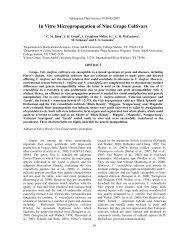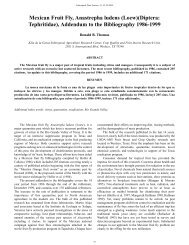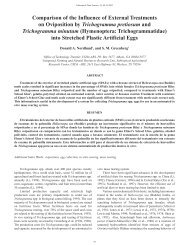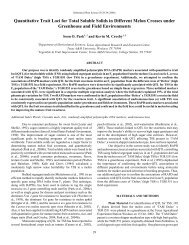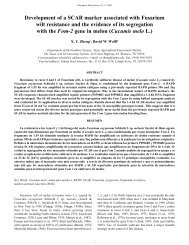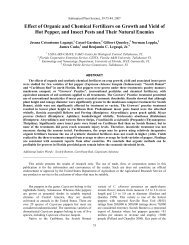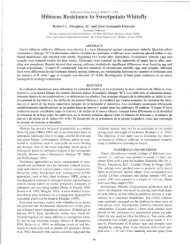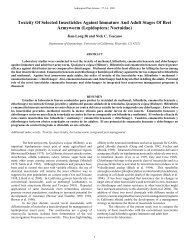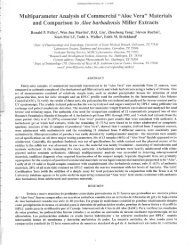Abstracts - Subtropical Plant Science Society
Abstracts - Subtropical Plant Science Society
Abstracts - Subtropical Plant Science Society
You also want an ePaper? Increase the reach of your titles
YUMPU automatically turns print PDFs into web optimized ePapers that Google loves.
Some New Information on Citrus psorosis virus in Texas.<br />
H. Miao, M. Seyran, J. V. da Graça, and M. Skaria<br />
Texas A & M University-Kingsville, Citrus Center, 306 N. International Blvd., Weslaco, TX 78596<br />
Four major tree-killing freezes (in 1951, 1962, 1983 and 1989) drastically reduced the commercial citrus acreage in the Lower<br />
Rio Grande Valley. Indirectly, these freezes reduced the incidence of citrus trees with symptoms of citrus psorosis disease. The<br />
development and commercial success of a new (psorosis-free) grapefruit cultivar, ‘Rio Red’ through mutation breeding of seedlings<br />
derived budwood also helped to reduce the overall incidence of psorosis in new orchards in Texas. However, in the past 6 years,<br />
we have observed field symptoms of psorosis in new plantations (post-1989), old plantations (trees pruned after the 1983 freeze),<br />
and dooryard trees (post-1983). In a recent survey involving 2,513 grapefruit trees of various varieties, obvious psorosis incidence<br />
was 3.5%, with another 4.9% showing psorosis-like symptoms. Biological indexing of several trees was done by grafting young<br />
shoots onto sweet orange (Pineapple, Dweet tangor, Madame Vinous) and Duncan grapefruit indicator plants. Typical symptoms<br />
were observed on indicator plants 4-6 weeks after grafting. The pattern of adjacent infected trees along flood irrigated rows in a<br />
commercial citrus orchard indicates a possible natural spread of this disease. A related virus in lettuce was recently showed to be<br />
spread by Olpidium. Preliminary studies conducted involving examination and sectioning of feeder roots from symptomatic citrus<br />
trees and culturing of soil with baits showed the presence of Olpidium-like fungus with resting spores. The Olpidium-like fungus<br />
in feeder roots of symptomatic trees strengthens the hypothesis of natural transmission of Citrus psorosis virus. However,<br />
verification of the virus-vector relationship needs to be established.<br />
Sclerenchyma Cell Deterioration of Citrus tristeza virus-infected Mexican Lime<br />
M. Skaria and H. Miao<br />
Texas A & M University-Kingsville, Citrus Center, 306 N.International Blvd., Weslaco, TX 78596<br />
Mexican lime leaf veins infected with a severe Citrus tristeza virus (CTV) strain (CTV-3) and a mild strain (T-TX 8) were<br />
compared. It is a universal indicator plant for diagnosing virtually all strains of CTV which can cause tree death, stem pitting, or<br />
mild reactions. Many translucent areas in the vein are prominent in the leaves infected with a severe strain and less prominent with<br />
mild strains of CTV. Cross sections of veins from the prominently translucent, slightly translucent, non-translucent, and ‘healthy’<br />
areas were compared for sclerenchyma cell degradation. These cells form a sheath around the leaf vascular bundles. They are thickwalled,<br />
lignified, and mineralized cells that provide mechanical support. Specimens for microscopy were prepared with free hand<br />
sections and stained with a Fungi-Fluor and examined under a Nikon Eclipse TE 300 fluorescence microscope with a<br />
CoolSNAP- Procf monochrome camera. In the severe strain infected plant, sclerenchyma cell degradation was 63% of the total<br />
cells in sections from the prominent vein clearing area and 34-48% in less prominent areas. In the mild strain infected plant, the<br />
highest cell degradation was only 40%. Sections from non-translucent and >healthy=areas had all cells intact. This appears to be<br />
the first quantitative report of sclerenchyma cell degradation associated with CTV infection.<br />
Effective New Lure Maximizes Anastrepha Fruit Fly Captures in North and South America<br />
David C. Robacker<br />
USDA-ARS Kika de la Garza <strong>Subtropical</strong> Agricultural Center, 2413 E.Highway 83, Weslaco TX 78596<br />
A synthetic lure developed jointly by IPM Tech (Portland, Oregon) and USDA-ARS (Weslaco, Texas) surpassed expectations<br />
for both attractiveness to Anastrepha and longevity in the field. IPM Tech lures outperformed Biolure (Suterra, Inc.) 2- component<br />
lures advertised effective for Mexican fruit flies (A. ludens) 5 fold when used on sticky yellow panel traps in grapefruit orchards<br />
in south Texas. In Peru, IPM Tech lures tested on sticky bottle traps outclassed standard (SENASA) ammonium phosphate McPhail<br />
traps 20 to 1 for captures of South American fruit flies (A. fraterculus) and over 100 to nothing for Mediterranean fruit flies<br />
(Ceratitis capitata). IPM Tech lures lasted upwards of 16 weeks in these tests. The IPM Tech Anastrepha lure shows great promise<br />
as a tool for detection and monitoring of the Mexican fruit fly, other species of Anastepha and the Mediterranean fruit fly.<br />
80



